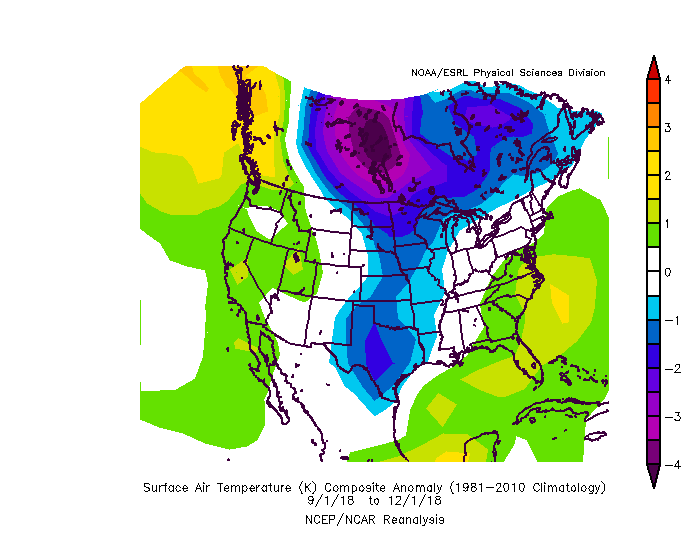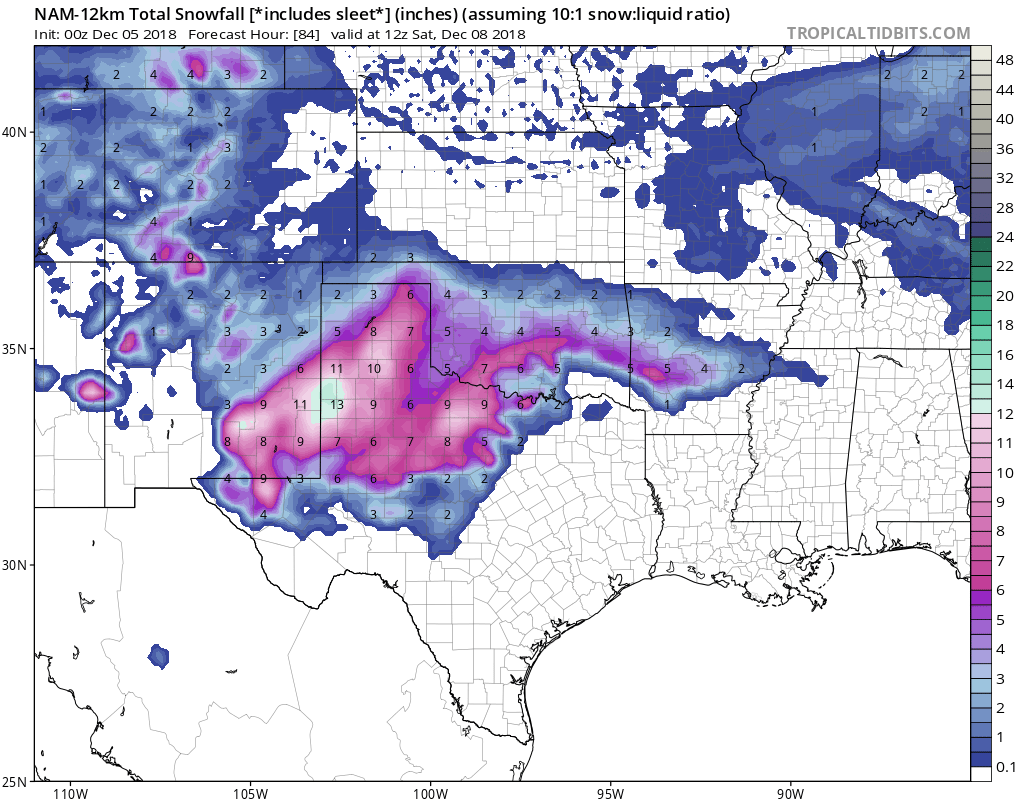#423 Postby weatherdude1108 » Tue Dec 04, 2018 5:08 pm
More educational discussion by the Ewx this afternoon, throwing around a few more technical terms.
 Area Forecast Discussion
Area Forecast Discussion
National Weather Service Austin/San Antonio TX
339 PM CST Tue Dec 4 2018
.SHORT TERM (Tonight through Wednesday Night)...
Afternoon surface analysis shows a surface high centered over
eastern Oklahoma with light northeast to east flow in place across
South Central Texas as a result. Clearing skies have allowed for 3
PM temperatures to rise into the low 50s to low 60s. With light winds
in place overnight and little more than thin cirrus moving overhead,
good radiational cooling tonight will allow for overnight
temperatures to fall into the mid 30s to mid 40s.
Mid-level ridging building over the region during the day Wednesday
ahead of a closed low off the California coast will allow for another
dry day for South Central Texas. However, the arrival of upper level
moisture with this ridge will produce increasing mid and high level
clouds and keep afternoon temperatures fairly similar to today in the
50s. A developing low level jet across the Rio Grande Plains
Wednesday night will result in increased moisture advection and allow
for a few streamer showers to develop west of the I-35/37 corridor
late Wednesday night. Cloud cover and increased mechanical mixing
from the low level jet will allow for some slightly warmer lows
Wednesday night with temperatures in the mid 40s to lower 50s.
&&
.LONG TERM (Thursday through Tuesday)...
An increasingly wet period appears to be setting up for South
Central Texas Thursday night through Friday night as a cold front
approaches the region from the north and an upper level system
translates east from the Pacific. A northern stream shortwave trough
diving across the Northern Plains towards the Great Lakes from Canada
will send this strong cold front surging south towards Texas during
the day on Thursday. At the same time, the low off the California
coast opens up into a shortwave and nears the Desert Southwest
resulting in increasingly southwest flow aloft across South Central
Texas. Southerly low level flow ahead of the cold front during the
day on Thursday will allow for continued moisture advection into the
region with early morning showers across the Rio Grande Plains
spreading east across the remainder of the region as the low level
jet veers. Showers during the day Thursday are generally expected to
remain light and scattered, but brief upticks in intensity or
coverage will be possible as embedded disturbances in the southwest
flow aloft track across the region from Mexico. Despite rain and
overcast skies on Thursday, warm air advection from southerly flow
will allow for temperatures to warm a few degrees into the low to mid
60s.
As the shortwave shifts closer to Texas Thursday night, mid-level height
falls on the order of 1 to 3 decameters will spread into West Texas
and increase to nearly 4 to 8 decameters through the day Friday as
the wave reaches the state. This will produce enough isallobaric
forcing for a low level jet to develop Thursday night and increase
into the 35 to 40 knot range during the day Friday with precipitable
water values climbing up into the 1.7-1.9 inch range during this time.
The cold front will continue to push south across Texas on Thursday
night, slowing as it reaches South Central Texas on Friday morning
with the increased low level flow.
As the front encounters increasing mid and upper level forcing with
its southward progress, scattered to numerous showers are expected to
develop as it moves into West Central Texas Thursday night with warm
air advection type showers developing south of the front across South
Central Texas as the front slows Friday morning. This
slowing appears to be somewhere in between the Hill Country and
Interstate 35 corridor with the latest round of model guidance, but
not all guidance stalls the front in the region. Increasing forcing
from the arrival of the shortwave looks to result in the development
of some kind of surface low or wave along the slowly-moving/stalled
frontal boundary during the day Friday, with the nose of the low
level jet overriding the wave and associated front and producing a
corridor of heavy showers and thunderstorms north of the frontal
boundary Friday afternoon or evening. As the main upper level system
begins to eject across Texas Saturday morning, this surface low will
drag the cold front across the remainder of the region with the
heaviest rain axis shifting south and east with it Friday night.
Deterministic model guidance remains fairly consistent in overall
rainfall amounts for the region during the Thursday night through
Friday night time period with roughly 2 to 4 inches of rain forecast
for east of a Rocksprings to San Antonio to Hallettsville line. What
they continue to differ on is the overall placement on where this
corridor of heaviest rain may occur, ranging anywhere from Central
Texas to the the Texas coast... and this is very much related to how
far south the cold front is able to make it as well as how far into
the state the nose of the low level jet extends. These types of heavy
rain events (usually called Maddox type events) consist of a
significant mid-level shortwave, a boundary nearly parallel to the
steering flow allowing for training of convective rains, and a strong
low level jet typically see the heaviest rain along and north of the
boundary where convergence is maximized along the nose (or leading
edge) of the low level jet. Because of inconsistencies with overall
frontal placement within guidance (further complicated by what
appears to be convective feedback from ongoing rain shifting the
frontal wave and consequently the front into different locations),
confidence in where the heaviest rain falls has not changed much from
the last forecast issuance. What does appear to be certain is that
heavy rain will impact parts of the region and this will be the
primary threat during the Friday and Friday night period. A brief or
transient severe threat may exist across the Coastal Plains during
the day given the amount of environmental shear, but with instability
appearing to be even lower than yesterday significant breaks in
cloud cover would be needed during the day Friday to allow for this
threat to materialize.
Rain is expected to quickly end west to east Saturday morning as the
parent shortwave kicks east towards Louisiana. Dry, cool, and breezy
conditions are expected Saturday and Sunday behind this system with
decreasing winds settling into the region by Monday.
2 likes
The preceding post is NOT an official forecast, and should not be used as such. It is only the opinion of the poster and may or may not be backed by sound meteorological data. It is NOT endorsed by any professional institution including storm2k.org. For Official Information please refer to the NHC and NWS products.
 The posts in this forum are NOT official forecast and should not be used as such. They are just the opinion of the poster and may or may not be backed by sound meteorological data. They are NOT endorsed by any professional institution or
The posts in this forum are NOT official forecast and should not be used as such. They are just the opinion of the poster and may or may not be backed by sound meteorological data. They are NOT endorsed by any professional institution or 









